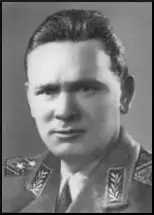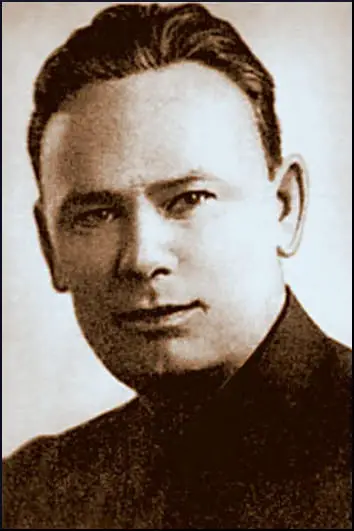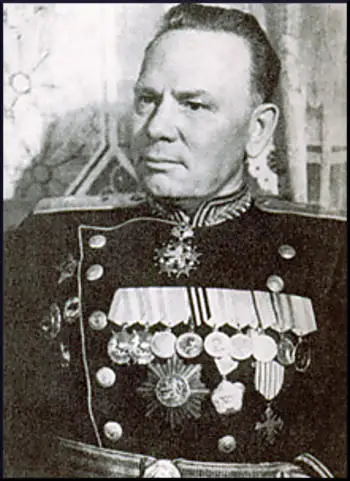Pavel Fitin

Pavel Fitin was born in Ozhogino, Russia, in 1907. He studied agricultural engineering at the Timiryazev Agricultural Academy. He served in the Red Army before working for State Publishing House. Fitin specialized in producing propaganda literature on the changes taking place in agriculture.
Pavel Fitin was recruited by the NKVD and worked in foreign intelligence. He was asked to carry out an investigation into supporters of Leon Trotsky in the United States. In the spring of 1937 he sent a message to the station chief in New York City to keep a close watch on James P. Cannon to see if he was in contact with Trotsky. Fitin noted that Cannon had joined the Socialist Party of America. He wrote that it is "our idea is to watch the Trotskyites through the Socialist Party since we do not have trustworthy agents inside the Trotskyist organization." (1) Fitin was one of the senior NKVD officers who encouraged Joseph Stalin to believe that Soviet agents abroad might be "Trotskyites". (2)
By the summer of 1937, over forty intelligence agents serving abroad were summoned back to the Soviet Union, as they were considered to be supporters of Trotsky. Theodore Maly, Yan Berzin, Boris Bazarov and Vladimir Antonov-Ovseenko, were amongst those recalled and executed. Ignaz Reiss, Alexander Orlov and Walter Krivitsky all defected. Reiss sent a letter to Joseph Stalin: "Up to this moment I marched alongside you. Now I will not take another step. Our paths diverge! He who now keeps quiet becomes Stalin's accomplice, betrays the working class, betrays socialism. I have been fighting for socialism since my twentieth year. Now on the threshold of my fortieth I do not want to live off the favours of a Yezhov. I have sixteen years of illegal work behind me. That is not little, but I have enough strength left to begin everything all over again to save socialism. ... No, I cannot stand it any longer. I take my freedom of action. I return to Lenin, to his doctrine, to his acts." (3)
Pavel Fitin - Foreign Intelligence Unit
In September 1939, Major Pavel Fitin, now the head of NKVD's foreign intelligence unit, reported to Lavrenty Beria, the Commissioner of Internal Affairs, that: "The American Trotskyite organization is the strongest in membership and financing among all the Trotskyite groupings." (4) A memorandum was circulated that suggested that one of the most important Soviet spies in America, Jacob Golos, was not to be trusted: "since he knows a great deal about the station's work, I would consider it expedient to bring him to the Soviet Union and arrest him." (5) Later that month Fitin wrote to Beria proposing the recall of two agents that had been "exposed to the agent Golos, who is strongly suspected of Trotskyite activities". (6) However, Golos was an American citizen and refused offers to visit Moscow.

Pavel Fitin took control of all the Soviet agents based in the United States. This included Jacob Golos, Joseph Katz, Joszef Peter, Judith Coplon, Elizabeth Bentley, Whittaker Chambers, Hede Massing, Alger Hiss, Donald Hiss, Laurence Duggan, Victor Perlo, Harry Dexter White, Nathan Silvermaster, Helen Silvermaster, Abraham George Silverman, John Abt, Noel Field, Nathan Witt, Marion Bachrach, Julian Wadleigh, William Remington, Lee Pressman, Harold Glasser, Charles Kramer, Duncan Chaplin Lee, William Ludwig Ullmann, Henry Hill Collins, Frank Coe, Mary Price, Cedric Belfrage, Lauchlin Currie and Hope Hale Davis. (7)
These spies were organized into networks. This included the Silvermaster group. Kathryn S. Olmsted, the author of Red Spy Queen (2002), points out: "Every two weeks, Elizabeth Bentley would travel to Washington to pick up documents from the Silvermasters, collect their Party dues, and deliver Communist literature. Soon the flow of documents grew so large that Ullmann, an amateur photographer, set up a darkroom in their basement. Elizabeth usually collected at least two or three rolls of microfilmed secret documents, and one time received as many as forty. She would stuff all the film and documents into a knitting bag or other innocent feminine accessory, then take it back to New York on the train." (8) Moscow complained that around half of the photographed documents received in the summer of 1944 were unreadable and suggested that Ullmann received more training. However, Pavel Fitin, who was responsible for analyzing the material, described it as very important data. (9)
German invasion of the Soviet Union
In December, 1940, one of Fitin's agents, Richard Sorge, sent a warning that Adolf Hitler was about to order the invasion of the Soviet Union. Over the next few months Fitlin's agents sent "over a hundred" intelligence warnings of preparations for German attacks that were forwarded to Joseph Stalin by Fitin. "The main blame for the catastrophic failure to foresee the surprise attack on 22 June belongs to Stalin himself, who continued to act as his own chief intelligence analyst. Stalin did not merely ignore a series of wholly accurate warnings. He denounced many of those who provided them." This included Pavel Fitin who was attacked by Lavrenty Beria for taking this warnings seriously. One Russian historian has claimed that "only the outbreak of war saved Pavel Fitin from the firing squad." (10)
Pavel Fitin thought it was important to build up a network of spies inside the Manhattan Project. However, at the beginning he was mainly reliant on Klaus Fuchs. Fitlin gave the project the codename "Enormoz". In November 1944 he reported: "Despite participation by a large number of scientific organization and workers on the problem of Enormoz in the U.S., mainly known to us by agent data, their cultivation develops poorly. Therefore, the major part of data on the U.S. comes from the station in England. On the basis of information from London station, Moscow Center more than once sent to the New York station a work orientation and sent a ready agent, too (Klaus Fuchs)." (11)
Another important source was John Cairncross. Pavel Fitin reported to Vsevolod Merkulov: "Valuable information on Enormoz is coming from the London station. The first materials on Enormoz were received in late 1941 from our source List (John Cairncross), containing valuable and absolutely secret documents both on the substance of the Enormoz problem and on measures by the British government to organize and develop work on the problem of atomic energy in our country. In connection with American and Canadian work on Enormoz, materials describing the state and progress of work in three countries - England, the U.S., and Canada - are all coming from the London station." (12)
Leonid Kvasnikov and the Atomic Spies
Frustrated at the lack of success in the United States in October 1944 he sent Leonid Kvasnikov to build up a network of atomic spies. Eventually he was able to construct a group that included Klaus Fuchs, Theodore Hall, Harry Gold, Julius Rosenberg, David Greenglass and Ruth Greenglass. Progress was still slow and one report states: "If we work this slowly in future, the Germans and the Russians may be the first to use the bombs while we still don't have them." (13)
Fitin constructed an amazing network of agents and informers. It has been argued by Christopher Andrew & Vasili Mitrokhin, the authors of the The Mitrokhin Archive (1999) that during the Second World War NKVD's "eager American and British agents continued to provide intelligence remarkable for both its quantity and quality." The NKVD "proudly calculated after the war that the grand total of its wartime agents and informers around the world had been 1,240, who had provided 41,718 items of intelligence." (14)

On 8th January, 1945, Leonid Kvasnikov sent a message to Pavel Fitin about the progress he was making. "(David Greenglass) has arrived in New York City on leave... In addition to the information passed to us through (Ruth Greenglass), he has given us a hand-written plan of the layout of Camp-2 and facts known to him about the work and the personnel. The basic task of the camp is to make the mechanism which is to serve as the detonator. Experimental work is being carried out on the construction of a tube of this kind and experiments are being tried with explosive." (15)
Kvasnikov suffered a set-back when one of his agents, Julius Rosenberg, was sacked from the Army Signal Corps Engineering Laboratories at Fort Monmouth, New Jersey, when they discovered that he had been a member of the Communist Party of the United States (CPUSA). NKVD headquarters in Moscow sent Kvasnikov a message on 23rd February, 1945: "The latest events with (Julius Rosenberg), his having been fired, are highly serious and demand on our part, first, a correct assessment of what happened, and second, a decision about (Rosenberg's) role in future. Deciding the latter, we should proceed from the fact that, in him, we have a man devoted to us, whom we can trust completely, a man who by his practical activities for several years has shown how strong is his desire to help our country. Besides, in (Rosenberg) we have a capable agent who knows how to work with people and has solid experience in recruiting new agents." (16) Kvasnikov's main concern was that the FBI had discovered that Rosenberg was a spy. To protect the rest of the network, Rosenberg was told not to have any connection with other members of the network. However, the NKVD continued to pay him "maintenance" and was warned not to take any important decisions about his future work without Krasnikov's consent.
The Soviet government was devastated when the atom bombs were dropped on Hiroshima and Nagasaki on 6th and 9th August, 1945. Allen Weinstein, the author of The Hunted Wood: Soviet Espionage in America (1999): "On August 25, Kvasnikov responded that the station had not yet received agent reports on the explosions in Japan. As for Fuchs and Greenglass, their next meetings with Gold were scheduled for mid-September. Moscow found Kvasnikov's excuses unacceptable and reminded him on August 28 of the even greater future importance of information on atomic research, now that the Americans had produced the most destructive weapon known to humankind." (17)
Pavel Fitin wrote to Vsevolod Merkulov: "Practical use of the atomic bomb by the Americans means the completion of the first stage of enormous scientific-research work on the problem of releasing intra-atomic energy. The fact opens a new epoch in science and technology and will undoubtedly result in rapid development of the entire problem of Enormoz - using intra-atomic energy not only for military purposes but in the entire modern economy. All this gives the problem of Enormoz a leading place in our intelligence work and demands immediate measures to strengthen our technical intelligence." (18)
Joseph Stalin died on 5th March, 1953. Lavrenty Beria now attempted to replace him as dictator of the Soviet Union. He was defeated by a group that included Nikita Khrushchev, Vyacheslav Molotov and Georgy Malenkov. Beria was arrested and accused of conducting "anti-state activities". Beria was found guilty and was executed on 23rd December, 1953. (19) Fitin, who was considered to be a close associate of Beria, was discharged from the NKVD and denied his pension.
Pavel Fitin died on 24th December 1971.
Primary Sources
(1) Pavel Fitin, report on the Manhatten Project (5th November, 1944)
Despite participation by a large number of scientific organization and workers on the problem of Enormoz in the U.S., mainly known to us by agent data, their cultivation develops poorly. Therefore, the major part of data on the U.S. comes from the station in England. On the basis of information from London station, Moscow Center more than once sent to the New York station a work orientation and sent a ready agent, too (Klaus Fuchs).
(2) Pavel Fitin report to Vsevolod Merkulov (August, 1945)
Valuable information on Enormoz is coming from the London station. The first materials on Enormoz were received in late 1941 from our sorce List (John Cairncross), containing valuable and absolutely secret documents both on the substance of the Enormoz problem and on measures by the British government to organize and develop work on the problem of atomic energy in our country. In connection with American and Canadian work on Enormoz, materials describing the state and progress of work in three countries - England, the U.S., and Canada - are all coming from the London station.
(3) Pavel Fitin, message to Vsevolod Merkulov (Venona File 40159 page 551)
Practical use of the atomic bomb by the Americans means the completion of the first stage of enormous scientific-research work on the problem of releasing intra-atomic energy. The fact opens a new epoch in science and technology and will undoubtedly result in rapid development of the entire problem of Enormoz - using intra-atomic energy not only for military purposes but in the entire modern economy. All this gives the problem of Enormoz a leading place in our intelligence work and demands immediate measures to strengthen our technical intelligence.
